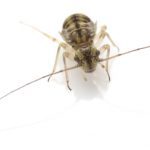Booklice Are Not Baby Termites!
By Chris Williams on October 19, 2012.
Question
My son was moving some cardboard boxes of motor oil that had been sitting in our crawlspace. Crawling all over the bottom of the boxes were these small, whitish insects or mites. They look like pictures I’ve seen of termites, except they seem to be too small. We didn’t find any infested wood or mud tubes or anything. Are these young termites?
Answer
 I can’t give you a definite answer without actually seeing what your son found. They could be termites because even termites will sometimes tunnel into damp cardboard and paper. But if they’re only about 1/16 to 1/8 inch long, they are probably booklice, also called psocids (pronounced SEW-sids). Booklice are white and soft-bodied and do kind of look like miniature termites, but they are only about 1/3 the size of termite workers.
I can’t give you a definite answer without actually seeing what your son found. They could be termites because even termites will sometimes tunnel into damp cardboard and paper. But if they’re only about 1/16 to 1/8 inch long, they are probably booklice, also called psocids (pronounced SEW-sids). Booklice are white and soft-bodied and do kind of look like miniature termites, but they are only about 1/3 the size of termite workers.
Booklice are not related to termites, and they’re not related to head lice or body lice either. They’re not lice or parasites at all. They got their name because they often infest books in damp locations like basements or garages. They feed on mold growing on starchy products, especially those in warm, dark, humid locations. They’re more of a problem in the summer months. They usually don’t cause any actual damage since they are feeding on mold on the surface, not on the underlying material itself.
Materials commonly infested by booklice include old books, stacked newspapers, stored cardboard sheets, and cardboard boxes. They also like the starchy glue in book bindings and on old wallpaper in humid areas. They can also be food pests at times, infesting moldy cereals, flour, or grains (including bird seed). In food warehouses, they can be responsible for food contamination, sometimes just by their presence in cardboard boxes. They can infest dried plant materials like straw matting, and even accumulations of dead insects in attics or in traps. Booklice are common (although temporary) pests in new construction where mold grows on still “green” building materials like damp lumber, drywall, or plaster.
Like other moisture-loving pests, booklice are easy to control just by reducing the relative humidity to eliminate mold. In living areas, use fans or dehumidifiers, or turn on heat or air conditioning, to circulate air and drop the humidity to less than 50%, making it unsuitable for mold and booklice. Once the building or area dries out, the mold and the booklice will be gone. If you’re not inclined to or able to dry out your crawlspace, you should remove any cardboard boxes, paper products or other materials that could be infested by booklice. Discard the boxes and move materials into plastic tubs instead. Isolate the removed crawlspace items for awhile in a dry location to kill any booklice present. If you have a large number of infested materials in your crawlspace, you might need to have a pest control company treat the area to kill the booklice. Unless the crawlspace is vented or dried out though, the booklice may return.